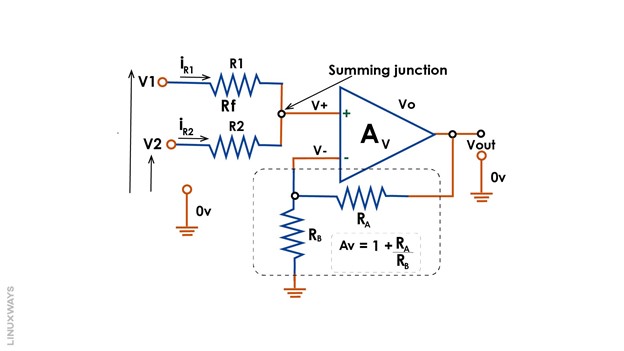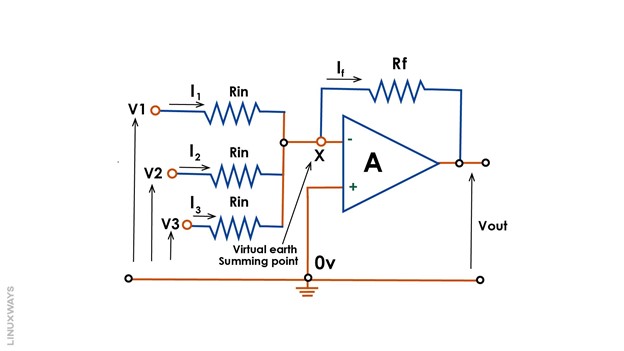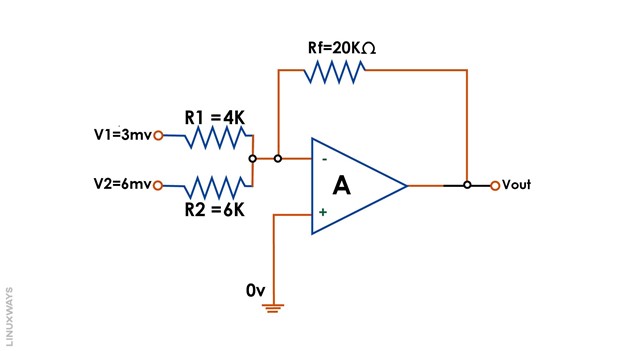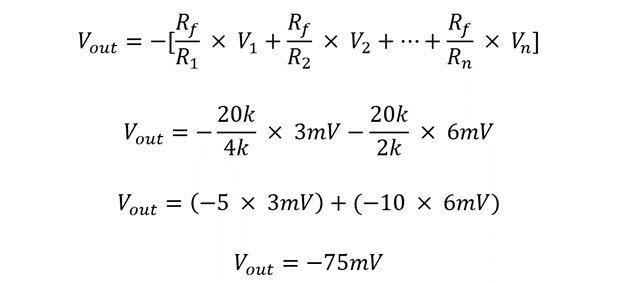Summing Amplifier – Op-amp Voltage Adder
A summing operational amplifier is a type of operational amplifier that can add up multiple voltage inputs applied either at its inverting or non-inverting terminals. It is also named a voltage adder since it adds multiple inputs and provides a resultant single output.

Depending upon the terminals to which voltages are applied, the summing amplifier is divided into inverting summing amplifiers and non-inverting summing amplifiers.
A non-inverting summing amplifier is produced by connecting voltages at its non-inverting terminals, while the portion of the output is feedback at the inverting terminal. The resultant sum of voltages obtained has a positive value.
Similarly, an inverting summing amplifier is produced when voltages are applied at the inverting terminal. The portion of the output voltage is now feedback at the non-inverting terminal, and the sum of voltages obtained has a negative value.
Non-Inverting Summing Amplifier
A non-inverting summing amplifier has two or more voltage inputs at its non-inverting terminal. The voltage inputs can be connected in parallel along with resistances almost equal in value as in the case of Rin of a non-inverting amplifier.
We are considering two voltage inputs V1, and V2 connected through two resistances R1 and R2 to the non-inverting input as shown in below figure.
Considering the summing junction point, KCL states the sum of all currents entering a node equals zero:
Substituting for IR1 and IR2:
The above equation can also be written as:
Considering resistances are equal, R1=R2=R:
Simplifying for V+:
Since the voltage gain of a non-inverting amplifier is given by:
Since its non-inverting configuration Vin = V+:
Substituting for V+:
The above expression shows Vout equals closed loop voltage gain multiplied by half of the sum of input voltages. Therefore, for op-amp to act as a voltage adder, RA and RB values should be selected so that voltage gain shall become ‘2’. In this way, the above expression will depict just the sum of the input voltages.
Inverting Summing Amplifier
When two or more voltage inputs are applied at the inverting terminal of the operational amplifier, it results in an inverting summing amplifier. A virtual summing point is added next to the voltage input resistances to facilitate in the calculations as shown below:
It can be seen that all the input voltages have been applied at the inverting (-) terminal to obtain an inverting summing amplifier configuration.
For the inverting amplifier, the output voltage for the first branch is given by:
Similarly, if we have n-channels:
The output voltage is the sum of all input voltage as given below:
Substituting for the voltage gain for the inverting amplifier:
Example
Calculate the output voltage Vout for the below summing inverting amplifier configuration. R1=4kΩ, R2=6kΩ while Rf=20kΩ, V1=3mV and V2=6mV:
Using the above expression for Vout:
The negative sign indicates that voltages have been applied at the inverting terminal (-) to attain the inverting summing amplifier configuration. Similarly, output voltage shall have a positive (+) sign when voltages would be applied at the non-inverting (+) terminal.
Applications
A summing amplifier can be used to add a mix of different input signals to generate an output. This is quite useful in audio mixers, voltage regulators, temperature measurements, level shifters, and power supplies applications.
Audio Mixer
An audio mixer combines multiple inputs from musical instruments to generate a single output to be fed into the amplifier. In the figure below, multiple inputs like vocals, guitars, and drums are applied at the inverting terminal to generate a single output beat. The summing amplifier is adding up all the inputs for a common output in this case.
Temperature Measurements
Temperature measurement applications can use the addition of multiple inputs for the purpose of addition of constant offset values for conversions from centigrade units to kelvin units are required. An offset value of 273.15 deg C can be added through another input in this case.
Level Shifter
Level shifters add a certain DC input level to AC input signals and provide a level-up version at the output. In level shifters, one input is the actual AC signal while the second input is the DC signal.
Conclusion
A summing amplifier acts just like a voltage adder when a bunch of voltages are applied at its inverting and non-inverting terminals. These amplifiers have a wide variety of digital applications where multiple signals are combined to get an output.















